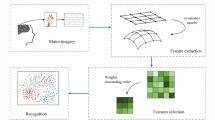Abstract
In a previous paper (Inbar, 1972/III) a new adaptive model was proposed for muscular control. According to that scheme muscle spindles (MS) supply continuous information about the system dynamics. In the present study integral pulse frequency modulation (IPFM) is used to correlate MS afferent signals, recorded from frog sartorius muscle, to the same muscle dynamics, in order to establish the feasibility of the proposed MS role in the adaptive muscle model.
Similar content being viewed by others
References
Brown,M.C., Matthews,P.B.C.: On the subdivisions of the efferent fibers to muscle spindles into static and dynamic fusimotor fibers. In: Andrew,B.L. (Ed.). Control and innervation of skeletal muscle, pp. 19–31. Edinburgh, E. S. Livingston Ltd., 1966.
Chaplin,R.A., Michalis,B., Coenen,R.: System analysis of biological receptors. Kybernetik 9, 85–95 (1971).
Inbar,G.F., Hsia,T.C., Baskin,R.L.: Parameter identification analysis of muscle dynamics. Math. Biosci 7, 61–79 (1970).
- Odom,B., Wagman,I.H.: Muscle spindles in muscle control: I. Afferent outflow from frog muscle spindles in open and closed loop modes. Kybernetik
- Muscle spindles in muscle control: II. Analysis of muscle servo model. Kybernetik
- Muscle spindles in muscle control: III. Analysis of adaptive system model. Kybernetik
Lee,H.C., Milsum,H.: Statistical analysis of multiunit multipath neural communication. Math. Biosci 11, 181–202 (1971).
Lennerstrand, G.: Position and velocity sensitivity of muscle spindles in the cat: I. Primary and secondary endings deprived of fusimotor activation. Acta physiol. scand. 73–74. (1968).
Li,C.C.: Integral pulse frequency modulated control system. Ph. D. Dissertation, Northwestern University 1961.
Matthews,B.H.C.: The response of a single end organ. J. Physiol. (Lond.) 71, 64–110 (1931).
Popple,R.E., Purple,R.L.: Repetitive firing in receptor neurons. Proc, of the IUPS Congress, Munich 1971.
Roberts,T.D.M.: The nature of the controlled variable in the muscle servo. In: Andrew,B.L. (Ed.) Control and innervation of skeletal muscle, pp. 160–168. Edinburgh; E. S. Livingston Ltd. (1966).
Terzuolo,C.A., Mckean,T.A., Poppele,R.E.: Impulse trains: coding and decoding. In: System analysis approach to neurophysiological problems, pp. 86–92. Minnesota; Brainerd, 1969.
Walløe,L.: Transfer of signals through a second order sensory neuron. Ph. D. Dissertation, Institute of Physiology, University of Oslo (1968).
Author information
Authors and Affiliations
Rights and permissions
About this article
Cite this article
Inbar, G.F. Muscle spindles in muscle control. Kybernetik 11, 142–147 (1972). https://doi.org/10.1007/BF00270670
Received:
Issue Date:
DOI: https://doi.org/10.1007/BF00270670




